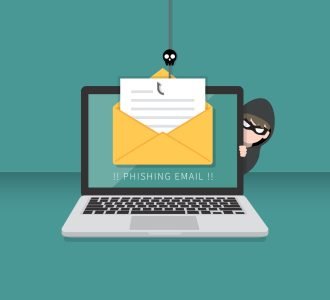5 ways to detect a phishing email when you get one.
“Phishing email“ is the most common type of cyber-attack that affects organizations like yours. Phishing attacks can take many forms, but they all share a common goal – getting you to share sensitive information such as login credentials, credit card information, or bank account details.
Although your IT Team will maintain controls to help protect your network and computers from such cyber threats, they rely on you to be their first line of defence to detect a phishing email and alert them as well as your other users. We’ve outlined a few different types of phishing attacks to watch out for
What are types of phishing emails

1-Phishing email
the most common type of phishing attacks are by email,you can know suspicious email by there fake domain that mimics a genuine organisation and sends emails of generic requests. The fake domain often have character substitution, like using ‘r’ and ‘n’ next to each other to create ‘rn’ to looks like ‘m’.In other cases, the fraudsters make a unique domain that includes the well known organisation’s name in the URL.
2-Whaling
Whaling assaults are much more focused, with senior executives as targets. Although the eventual aim of whaling is the same as it is for any other type of phishing assault, the approach is far more covert.
Tricks like bogus links and malicious URLs aren’t useful in this case since crooks are attempting to impersonate senior workers.
Whaling emails frequently exploit the ruse of a busy CEO asking an employee to perform them a favor.
3-Vishing and smishing
Telephones have replaced emails as the primary mode of contact in both smishing and vishing.
Smishing includes criminals sending text messages with similar content to email phishing, whereas vishing involves a telephone call.
Messages purportedly from your bank warning you to questionable activities are a popular smishing pretext.
4- Spear phishing
There are two more, advanced types of email phishing.
The first, spear phishing, refers to malicious emails delivered to a specific individual. Criminals that do this will already have some or all of the victim’s personal information:
- Email address
- Place of employment
- Specific information about their job role
5-Angler phishing
Social media, a relatively new attack vector, provides various opportunities for crooks to deceive people. Fake URLs, cloned websites, postings, and tweets, and instant messaging (which is effectively the same as smishing) can all be used to trick individuals into disclosing personal information or downloading malware.
Criminals, on the other hand, may develop highly targeted assaults using the data that individuals freely disclose on social media.

How to detect a phishing email
1.The email is sent from a public email address.
No reputable organization will send emails with the subject ‘@gmail.com’. No one, not even Google.
2.The domain name is misspelt
Another signal contained in domain names gives a good indication of phishing frauds, however it confuses our prior tip.
The issue is that any registrar may sell a domain name to anyone. And, while each domain name must be unique, there are several techniques to generate addresses that are indistinguishable from the one being faked.
3.The email is poorly written
Poor spelling and grammar are typically indicators that an email is a hoax.This, however, only applies to ridiculous scams like the oft-mocked Nigerian prince hoax, to which you must be extremely gullible to fall victim.
4.It includes suspicious attachments or links
Every phishing email, no matter how it is delivered, contains a payload. This will either be an infected attachment or a link to a fraudulent website.These payloads are designed to collect sensitive information such as login passwords, credit card data, phone numbers, and account numbers.
5.The message creates a sense of urgency
The longer you think about something, the more likely you are to detect anomalies.
Perhaps you discover that the organization does not contact you through that email account, or you chat with a coworker and discover that they did not send you a paper.
Even if you don’t have that “a-ha” moment, revisiting the message with fresh eyes may help expose its actual character.
That is why so many scams demand that you respond quickly or it will be too late. This has been clear in each of the examples we’ve presented thus far.

How to protect yourself from phishing
1-Use security software for your devices and update them continuously .
2-Never put your confidence in anybody who seeks sensitive information by email.
3-Never trust a source that doesn’t know your full name,job role and account information.
4-Make sure URL is secure have https and there is lock icon beside URL.
5-Be a were from email attachments and do not open them ,they may contain malware.
6-Be wary of pop-ups in untrusted websites , which are frequently employed in phishing attacks.
What are the risk posed by phishing attacks?
For financial benefit, attackers may be content with obtaining a victim’s credit card details or other personal data. At times, phishing emails are sent in order to collect employee login credentials or other details for use in a sophisticated assault on a specific firm. Phishing is a common starting point for cyber crime assaults such as advanced persistent threats (APTs) and ransomware.
see more other IT tips for your business from Chipin website




